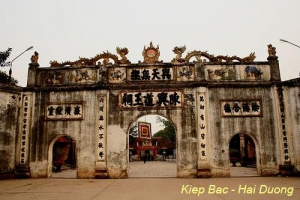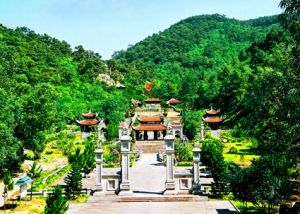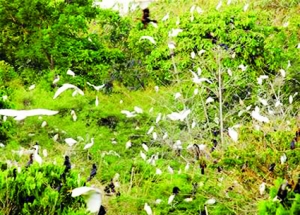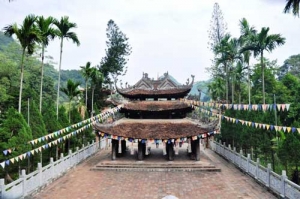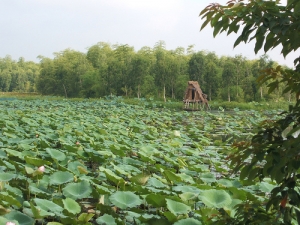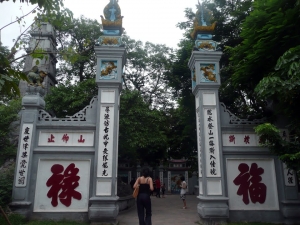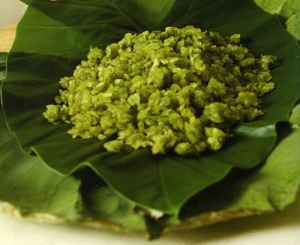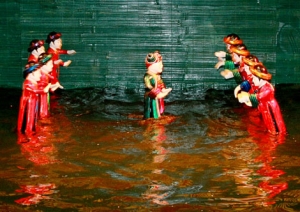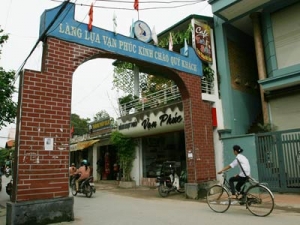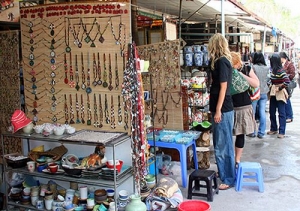
Asia Pacific Travel Team
Kiep Bac Festival - traditional national identity festival
The main day of the festival occurs on the 20th day of the 8th lunar month, but from the previous days onward, the festival attract many visitors from all over the country to the Con Son – Kiep Bac cultural and historical site in the northern province of Hai Duong.
The legend behind...
Millions of people throng Kiep Bac Temple to participate in the festivities. The festival takes place from the 15th to 20th days of the eighth lunar month, when autumn is in its full bloom. Kiep Bac Festival is celebrated every year on the death anniversary of Saint Tran. The place was one of his hideouts and the temple was built in the memory of the saint.
 Victory of the battle in Bang Dang River
Victory of the battle in Bang Dang River
Tran Quoc Tuan was the general who defeated the Chinese Nguyen-Mong invaders three times. Because of his merits to the nation, he was proclaimed a saint. General Tran Hung Dao had planned for this; he had spent months studying the river and embedding the spikes in the riverbed as his forces of soldiers and peasant conscripts harassed the Mongols. They fired flaming arrows and attacked the damaged boats on water, destroying the entire flee and the Mongol army was thus defeated by Tran Hung Dao for the second time. The only other nation to successfully resist the Mongols was Japan. The battle of Bach Dang is legendary across the world and considered a brilliant piece of strategy and its mastermind, General Tran Hung Dao, is both hero and saint in Vietnam.
Features of the festival
The festival bears the special characteristics of the traditional national identity. One of the most interesting activities in the festival is the boat race on the Luc Dau River, in which hundreds of boats participate. The boat race is like flying arrows rushing through the air as the boats are urged along by drumming sounds and the screaming of excited people. Taking part in the Kiep Bac Temple Festival, participants relive the atmosphere of when Tran Quoc Tuan placed his troops into a battle-array. This festival makes the Vietnamese people feel proud of the glorious traditions of their nation.
The main ceremony is followed by a great ceremony with elaborate worshipping procedures. This ceremony is followed next by a procession where Saint Tran's ancestral tablet is brought on a golden procession chair, passing three walled gates toward the river bank. The procession chair is then placed on a royal barge. The procession march lasts for two hours and then Saint Tran's ancestral tablet is brought back to the main temple for the last religious service.
Colorful processions start on the morning of the 20th day from Van Yen, Duoc Son and Con Son for the temple. The procession embarks on the boat ornamented with votive flags and flowers. The Saint’s palanquin is transported on a dragon boat. The fleet leaves the quay in the resounding accompaniment of drumbeats, gong and horn sounds, and the admiring acclamation of the audience. When the fleet moors, the procession returns the temple.
 Kiep Bac Festival in Luc Dau River
Kiep Bac Festival in Luc Dau River
After all the processions gather at the gateway to the temple at a definite time, the ritual of incense offering takes place. The head of the religious ceremony delivers a speech to commemorate the efforts of Tran Hung Dao and the history of the anti-Yuan-Mongolian struggle during the Tran regime. After the deliverance of the funeral oration by the officiant, people offer incense sticks. A vibrant ceremony characterized by a palanquin procession takes place after the completion of the incense-offering ritual. The blessed tablet of Saint Tran is kept in a red lacquered and gold gilded palanquin embellished with dragon and lion dancers around. The procession leaves the dock accompanied by enthusiastic drumbeats, gong and horn sounds and the zeal of the followers. A major attraction of the festival is the race of dozens of boats on the Luc Dau River. The enthusiastic people come from nearby Hanoi and other places beyond. All gather with the belief that Vietnam is a country that will never succumb to a foreign power. Notwithstanding the modern elements that have been incorporated to the festival, it has retained its traditional fervor.
Tens of thousands of Vietnamese people make the pilgrimage to celebrate not only their great general, but their nation’s proud military history. They are united by a belief and a great notion that Vietnam is a great country and it has not and will never bow to a foreign power.
Visitors who join Kiep Bac Temple Festival seem to live in the same atmosphere as when Tran Quoc Tuan arrayed his troops in the bank. The Vietnamese are very proud of the glorious traditions of their nation.
If tourists in Vietnam Travel have chance to visit Hai Duong Province, Kiep Bac temple is a must-see place that should not be missed!
Con Son Mountain - Historical and national attractive destination
Con Son Mountain looks like a resting lion. With a shrine on the top, its 238m northern ridge adjoins Ngu Nhac Mountain. Con Son borders U Bo Mountain and a valley with bamboo hedges to the west. Next to it is the 72-peak Phuong Hoang (phoenix) mountain range with its vast pine forests, sparkling streams, rugged cliffs and ancient towers and pagodas.
Con Son is also known as Tu Phuc or Hun. In the 10th century, Dinh Bo Linh, who would later become future King Dinh Tien Hoang, from Hoa Lu in present-day Ninh Binh Province rose up against 12 warlords competing for power. Pursued by Dinh Bo Linh’s forces, Pham Phong At, one of the warlords who ruled the northeast region, fled to Con Son Mountain to hide together with his entourage. Following the advice from his subordinate, Dinh Bo Linh set the forests on fire to smoke out the warlord, who had to surrender and was captured.
Located at the foot of Con Son Mountain is Con Son Pagoda built at the end of the 13th century. The pagoda was one of the three centers of the Buddhist Truc Lam Trinity under the Tran Dynasty (1225-1400). The pagoda was extended in 1329 and underwent several restorations during the 17th and 18th centuries and in the last few decades. But the pagoda’s slipper-shaped tiles and stone pedestals from the Tran Dynasty are still preserved.
Gieng Ngoc ( Pearl Well)
Gieng Ngoc, or Pearl Well, is located on the side of Ky Lan Mountain at the foot of a tower. Legend has it that in the full moon night of the seventh lunar month, Huyen Quang, one of the founders of Truc Lam Zen Buddhism, sleeping in his room at Con Son Pagoda dreamt of seeing a shiny pearl on the side of the mountain. He wanted to get closer to scrutinize the pearl, but the sound of the pagoda’s bell woke him up. However, he could not stop thinking about his dream. So together with his assistants, Huyen Quang went to the mountain. There he found a well containing fresh and cool water. When the monk returned to the pagoda, he held a ceremony to thank the deities for the precious source of water. He also made the well deeper. Since then, the Pearl Well’s water has been offered in rituals at the pagoda.
Am Bach Van and Ban Co Tien

Ban Co Tien in the Con Son mountain
Am Bach Van (white cloud temple) stands on the flat top of Con Son Mountain next to Ban Co Tien (fairy chessboard) and several other large flagstones called “immortal chessboards” by local residents. Six hundred rocky steps lead up to the chessboards.
According to legend, visitors from Kinh Bac (northern citadel) arrived in Con Son on autumn afternoon. After offering incense and enjoying the scenery, the visitors stayed at the pagoda. Early the next morning, they went to the mountain to play chess and drink wine. On the way up the mountain they heard chatter and laughter. But when they reached the temple on the mountain’s top no one was there, just a board with chess pieces showing an interrupted game. The visitors thought that some heavenly deities must have ridden clouds to Con Son Mountain to play chess and hurried back to heaven when somebody approached the top of the mountain.
Con Son Stream and Thach Ban
Aside from these magic places, Con Son boasts many pine tree forests, some having grown for several centuries, and several smaller forests of bamboo, myrtle and peony. When the spring comes, it looks as if Con Son wears a flower dress.
Gently flowing all year round, Con Son Stream is also a well-known tourist destination. Locals call the two large flat rocks on the stream’s banks Thach Ban (stone table). A legend says Nguyen Trai (1380-1442), a politician and poet under the post-Le Dynasty (1427-1789), used to sit on these rocks, composing poems and pondering national issues.
Nguyen Trai Temple
The temple was dedicated to Nguyen Trai, built at Con Son in December 2000 and inaugurated in 2002 in celebration of the 600th birthday anniversary of Nguyen Trai.
The constructions of the temple cover an area of 10,000m². The main temple stands at the foot of To Son Mountain, flanked by two mountains An Lac and Ngu Nhac. To its right is Con Son Stream. Inside the temple there are also the right and left ceremonial halls, inside and outside gates, stele house, the urn for burning votive offerings and Nghia Lake. The temple is a token of gratitude of the Vietnamese people to Nguyen Trai, the World Cultural Celebrity.
If tourists in Vietnam Travel have chance to visit Hai Duong Procinve, Con Son mountain is a must-see place that should not be missed!
Eco-tourism, Entertainment and Amusement in the Suburbs of Hanoi
Suburbs of Hanoi known for its beautiful landscape and hospitable people, which attracts many visitors in Vietnam Tourism both at domestic and abroad.
Hanoi has been considered a safe and attractive destination by international tourists in Vietnam Tourism. Apart from abounding with relics and beautiful places, Hanoi, a land with a millennial culture, is an ideal location for eco-tourism, amusement and entertainment, particularly around its suburbs. its also known for its beautiful landscape and hospitable people, which attracts many visitors both at home and abroad.
Traveling to Perfume Pagoda in the cold season
The Perfume Pagoda (Vietnamese: Chùa Hương) is a vast complex of Buddhist temples and shrines built into the limestone Huong Tich Mountains. The centre of the Perfume Pagoda lies in Huong Son Commune, My Duc District, former Ha Tay (now Hanoi).
When cold weather rushes and cover the pagoda, Perfume Pagoda becomes empty, quiet. In that cold weather, sometimes, the sound of boat which takes tourists in Vietnam travel to sightseeing the pagoda.
Boats are empty of people, visitors in Vietnam Tourism needn't worry about hustle, pushing or waiting. Yen Stream (Suối Yến) is peaceful, let us retreat without the grief.
Around, all things are silence and quiet. Sometimes, tourists in Vietnam travel can hear the sound of fluttering leaves, song of birds and "baah" cry of goats on mountain.
Rarely, you encounter a group of tourists visiting. So, if you have passion for taking photos, you can do comfortablely without anxiety many people obscured the beautiful landscape.
Therefore, if you have free time, traveling to Perfume Pagoda in the cold winter, discovering by yourself and enjoying particular feeling!
Each spot of Perfume Pagoda is surrounded by the cold weather. So, there isn't crowed scene of travelers in spots.
The secret beauty of Dam Long - Bang Ta forest eco-tourist area
This area is located in Son Tay town, about 70 kilometers from the central of Hanoi. It covers 70 hectares including 50 hectares of water surface and 20 hectares of forest.
Bang Ta primeval forest will surely conquer tourist in Vietnam Tourism who have the passion for discovery. The fauna and flora here are abundant, with 240 species of trees and many species listed in the red book. The most profuse is a group of 76 valuable medicinal herbs.
It has four layers of trees. The highest layer mainly consists of trees on average from 30 to 35 meters tall. The next layer is chestnut trees and fuchsia, between 20 and 25 meters high. The third layer is mainly ricinus, oleander, mulberry, soapberry trees, and bead trees, and the lowest layer includes a variety of fern and mistletoe, creating a beautiful look.
Travelling to Bang Ta primeval forest, tourists in Vietnam travel may catch the sight of many kinds of birds; watch the stags and deer wandering in the quiet old forest, enjoy the melody of tens of species of birds. Sometimes, tourists will be surprised by the hundreds of monkeys gathering around hundred-year-old green trees.

After that, tourists in Vietnam travel will contemplate the beauty of Dam Long, an immense lake filled with lotus spreading their fragrance in summer, and birds, reptiles such as suamp hens, boucals, geckos, and lizards. Water sports in swimming pools or games on rope bridges or cau khi, characteristics of the southern region will excite young people. It's also a great ideal to ride a bicycle around the forest to breathe the fresh air in the morning on the wonderful path.
Coming here, tourists in Vietnam travel can stay at dtilted Muong ethnic minority houses, enjoy camp-fires, "ruou can" (wine drunk out of a jar through pipes) and traditional music.

The local markets is also interesting with souvenirs, specialties. Then, tourist in Vietnam travel can visit many near location, such as Ngoc Nhi stork garden, Suoi Hai (Double Stream), and Ao Vua (Pond of Kings).
Escaping from the bustle and hustle of urban life and travel to Dam Long-Bang Ta forest eco-tourist area, tourists in Vietnam travel will discover the wild and secret beauty of forest and mountain with many amazing things.
Ngoc Son Temple on Hoan Kiem Lake - the cultural beauty of Hanoi
Hoan Kiem Lake was already considered the most beautiful lake in Hanoi when Ngoc Son Temple was built on an island in the 19th century. Initially, the temple was called Ngoc Son Pagoda and was later renamed Ngoc Son Temple, since temples are dedicated to saints.
Saint Van Xuong, considered to be one of the brightest stars in Vietnam's literary and intellectual circles, was worshipped there. National hero Tran Hung Dao is also worshipped after he led the Vietnamese people to victory over the Yuan aggressors.
The temple as it is today is the result of renovations made by Nguyen Van Sieu in 1864. A Confucian scholar, Nguyen Van Sieu had a large pen-shaped tower built at the entrance of the temple. On the upper section of the tower, also called Thap But, are three Chinese characters Ta Thanh Thien, which literally means "to write on the blue sky” is to imply the height of a genuine and righteous person's determination and will; Dai Nghien, meaning "ink stand", is carved from stone resembling a peach placed on the back of the three frogs on top of the gate to the temple; and The Huc, meaning "where rays of morning sunshine touch".
 Thap But - mean to write on the blue sky
Thap But - mean to write on the blue sky

On the way to the temple there are several parallel sentences (cau doi), written on the walls. These cau doi were part of traditional word puzzles played by educated individuals.
"Cốm" - Gracious of Hanoi People
Come to Hanoi, who do not remember a famous appetite present that tender rice . The first gift has just recently that gracious called "Cốm of Vong village”.
The early autumn, walking in the area we see sweet growing rice break season alternating with grass smell, smell of home. Village people go round and break the rice for 24 hours to hand in the processing of the paddy seeds to Cốm.Making Com is not simple. Method of communication is always confidential: only the parents transmitted to the son, not to most people for the daughter because when you go get her husband's daughter will bring method to cook the other.
Talk about how make Cốm, of course many areas of the country that must recognize that no where do seeds cốm flexible and delicious in the Vong villages. People of Vong village who cook very elaborately. Type rice snow rise seeds that type make Com.There are many types: sticky fat varieties, Japanese sticky, flowers yellow sticky, sticky stations first, then ... Rice's daughter and then exposed to color. Then wait to ensure the rice grains (but is certainly green, not red, yellow) on the cut. Rice cutting on absolute or may not be beating, but pluck to golden paddy seeds leave. People that: secrets of the time with cốm take in the island said. All skill plus experience helped traditional village for cốm Vong very flexible, always have a fire, especially wood heater must be first special wood not used to wood or wood straw spots. The consequent need to lastly mirror light, thoroughly; pestle is not too heavy, which is all hands must not be delayed because cốm calming.

After completed, it will take to improve in the light most seeds cốm (cốm is the first fork). While the second cốm cốm is often all but three is not to complete the food is right, need to go through a stage is a more.
They get the rise seeding grind , socialize with water make a product green color and leaves them to cốm true for all hands. Once they finished, com is in a very thin piece of the banana leaves or lotus leaves and then assigned to bins load going to sell. Blue natural cốm plus artificial blue as a blue village for cốm Loop. Com village with a very thin, and the number of hands is appeased for the flavor of the rice.

To enjoy the full flavor of cốm we must eat com, not include anythings. And not cốm have long been a popular food can not be lacking. In addition to eat, people still processing cốm many other dishes. First cốm itself. Cốm because a food may not be long to think of how compressed cốm, not to cốm landmark but still flexible and delicious.

After this, people do the pie, grilled job media has thought out and a cốm grilled (pig grilled with cốm) eat dust, fat and fragrant. It is said that father cốm time to eat hot new enjoy the taste of it.
If tourists in Vietnam Travel have chance to visit Hanoi, you should try "Cốm" and buy as souvenir for your friends and parents. it's very delicious and gracious!
Thang Long Water Puppet Theatre - Having traditional unique culture Vietnam
Located at 57B, Dinh Tien Hoang street, nearby Hoan Kiem Lake, Thang Long Water Puppet Theater is a familiar address for both domestic tourists and foreign ones, who want to enjoy water puppet shows and discovery the beauty of this unique Vietnam traditional art.
The formation and development of Thang Long Water Puppet Theatre
In 1969, the theater was established and since 1990; many water puppet shows have been performed by Thang Long theater artists.Since being established, our main task is to serve domestic audiences and tourist with "165 performing days". Besides, Thang Long Water Puppetry Theatre has introduced this traditional art of Vietnam to other countries and attended International Art Festivals in Asia, Europe, Australia, Latin America. Vietnamese water puppetry shows are warmly welcomed and highly appreciated wherever they are staged. The famous Thang Long Water Puppetry Theatre has been performing in many countries:
+1999: Sydney (Australia), Athens (Greek).
+1998: Spain, Portugal, Iran, France, Italy, Philippines.
+1997: Italy, Mexico, France, America, Belgium.
+1996: Spain, Brazil, America, France.
+1995: Denmark, America, Spain, Portugal, Japan.
+1994: Australia, Spain, France, Switzerland, Korea.
+1993: Hongkong, Japan.
+1992: Japan, France, Thailand.
Traditional content of water puppet performance like daily life of Vietnamese farmers (cultivating, tending buffalo, catching fishes…), communal entertainment (swimming contest, dragon dancing…), or historical legends (Le Loi returns precious sword…), with modest performance way have appealed audiences for centuries. However, the artists of Thang Long Water Puppet Theater want to renew the old puppet shows with effect of light, music and combination between people and puppets.
 Le Loi King
Le Loi King
It sounds risky, but the theater has been successful since the beginning the beginning and received favors and praises from audiences. To enjoy some typical water puppet performances, you can take a look at the video below.
Certainly, it will be much great if tourists can directly watch these shows in Thang Long Water Puppets Theater after enjoying a cup of coffee in the coffee lounge which is right in front of the theater, and giving a nice view to Hoan Kiem Lake.
If tourists in Vietnam Travel have chance to visit Hanoi, Thang Long Water Puppet Theatre is a must-see place that should not be missed!
Charming Van Phuc Silk Village
Van Phuc Silk Village is situated on the banks of Nhue Thi River, Nguyen Trai Road, near Ha Dong city, 8 km southwest of Ha Noi. It takes you only 30 minutes by motorbike to go there from the centre of Hanoi. The village has been much well known for its traditional sericulture, weaving, and silk products. Tourists coming here are lured by various beautiful shirts, crafts, ties, dresses and many other things made of silk available in the village. What is special is that the silk is made by very simple looms, which is the genuinely traditional Vietnamese way of making silk.
The cradle of Vietnamese Silk
For centuries, silk has always been considered an extreme luxury, on par with rhinoceros horn, ivory and precious handworks in Vietnam. It has long been a universal byword of luxury, often worn by the richest, most powerful citizens. Most visitors somehow have heard about the significant role of this kind of material in Vietnam, yet might wonder where the cradle of Viet silk is. The mentioned Van Phuc Silk Village is proud to be the origin of best silk and silk-making industry of Vietnam, which is attached to a long-lasting history of more than two thousand years. Though passing by lots of ups and downs, during the recent years, the village’s craft has enjoyed revival due to a surging demand for silk in both the domestic and foreign markets.

Today, the fine and lustrous cloth that originates from the cocoon of the silkworm is more affordable for "ordinary" folk. Furthermore, silk is currently enjoying a fashion renaissance, particularly since its many varieties can be made into a wide range of designs suitable for all facets of modern life. Should you intend to have a silk pair of formal clothes made, just come here and select your suitable materials, and professional tailors here will bring you satisfaction!
Ideal place for silk products & souvenirs
Like other visitors to the village, you will be surprised at this “silk shop town”, where almost all houses along the paths have been turned into shops selling silk products. Specifically, the village is now home to 1,280 households, 90% of whom are involved in silk production and business. The village makes more than 2 million meters of silk per year. Yet, more than that, you are offered a good chance to explore the Vietnamese traditional industry of silk-making.
No tourists here are uncontented with the glisten of various silk products. They are always confronted with an initially bewildering array of silk products, from raw materials, to garments, and a myriad of silk accessories. The local silk is known for its smooth and lightweight appearance, and qualities that enable it to be dyed more colors to suit a variety of skin tones.

In order to cater for the changing demands and tastes of customers, Van Phuc silk producers are expanding their silk and garment repertoire: traditional glossy, embroidered silks, double layers, wrinkled silks, and of course, more colours, hues and weights, for which they have invented new techniques in dying and thermo-processing the threads.
If you are going to buy something from Vietnam as gifts for those at home, silk and clothes made of silk are available around in the village for your choice. Though the days when Vietnam's silk was reserved for nobility are long gone, what would never change is the sense of romance and luxury imparted by silk, a luminous cloth type. With 2000 years of history behind them, the silk weavers of Van Phuc Silk village are still busy, weaving dreams.
How to get there?
With a view to reaching Van Phuc village, tourists in Vietnam Travel should travel south west out of Ha Noi on Nguyen Trai Street until they reach the border of Ha Dong District. Then turn right and dive for about 3km. The village is on the left, some 8 km from central Hanoi. Motorbike, bus, or taxis are all of good use.
Bat Trang Village - traditional ceramic and pottery village
Bat Trang, a small village in the north of Vietnam, is about 13 kilometers south east of Hanoi center, on the other side of Chuong Duong bridge. Why is its name popular to most tourists to northern Vietnam? The answer is its ever famous ceramic and pottery products of high quality. If you have known about Vietnam, you may not be surprised that Bat Trang’s vases, bowls, dishes, and many other kinds of ceramic products have been exported worldwide. Should you would like to contemplate workers making ceramic products by hand, just come here! What’s more, you can also try it yourself!
History of Bat Trang village
Bat Trang village is said to be established in 14th or 15th century in several documents. However, according to the villagers, the village perhaps appeared earlier. There are always two stories concerning the village origin. One of these tells that under Ly dynasty, in 1100, when the nation was in its independence and initial growth period, there were 3 scholars who came back from their mission trip to China bringing the ceramic craft industry learned there back to Vietnam and taught the people of Bat Trang. In the other story, in the village history dates back to the 10th century, when King Ly Cong Uan relocated the capital in Thang Long. With the establishment and development of the capital, many businessmen, crafters from many areas come to settle down here to work and trade. In Bat Trang, there was a lot of white clay, so that many potters, among whom was Nguyen Ninh Trang family, came and built the kilns here. Accordingly, Bat Trang has gradually changed from a normal ceramic and pottery village into a famous ceramic and pottery centre until now.
As time went by, the village’s products have developed and become well known for the best quality, style and glaze, both inside and outside of the nation. Many of these are now customized for aristocratic families and religious needs. Its popular foreign markets are Japan (under the brand "Kochi (Giao Chi) ware"), the Netherlands, Britain, Portugal, Southeast Asia, etc.,
The famous ceramic & pottery products
Production Process : To produce a complete product, one must follow 3 steps. The first step is making the product frame. The artists select the suitable clay, treat it and start making a raw product. It must be repaired to get the best appearance. Secondly, they decorate and cover it with glazes. Last but not least, the raw products are baked in 3 days and 3 nights. There are several kinds of kiln, yet the temperature must be at 12000 or 13000. After baking, products are brought out, classified and repaired in case there are mistakes. And now we have the perfect product.
 Decorating cearmic products
Decorating cearmic products
Popular product types. Bat Trang products are divided into 3 kinds based on the purpose of use.
- Utilitarian wares: including plates, bowls, teacups, kettles, wine bottles, flowerpots, vases, jar… What differs is that they are thicker than Chinese ones.
- Cult wares: comprise lamp stands, candle holders, incense burner, altar boxes, swords… These are valuable for collectors because of inscription of the production years, the names of the producers and the potters.
- Decorative objects: house models, altars, statues and architectural fixtures.

The special trait is the diversified decorations on the products. Thanks to a long–lasting history and development, the village’s works have been accumulated with a lot of different special designs. One more thing that makes them distinguished is the glaze, which is of high quality and a variety of colors, such as blue, brown, white, moss green, in both breaking and melting glazes.
In fact, there have appeared a number of competitors both domestically and internationally who take advantages of high technology. Yet most customers prefer the craft products that contain historical and traditional values. Hence, it is no surprise at all that Bat Trang is still found in busy days and works. More importantly, the village is now so popular that absorbs a huge annual number of tourists to visit and buy ceramic goods.


